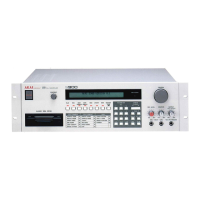19
Fig.
4
Key held down
loop
repeats
01
j
500
point
| ;
points
Note
abrupt
level
change
Fig.
5
Looped
portion
No
abrupt
changes
New loop
length
A sustained
tone,
such
as a flute,
is easier to loop
than a percus-
sive
tone, which
does not
have a steady level.
To loop
a percus-
sive
sound,
try
limiting or
compressing
the
sound when
sam-
pling
to even
out
volume
variations, then
use
a
short
sample
length
located fairly
late
in the
note's
decay. Since the
note now
sustains
continuously,
and
you want it to
decay,
use
the
S900's
on-board
envelope
generator
(see
EDIT
PROGRAM, Page
09) to
add an artificial
decay effect.
Another
solution
is
to use alternate
looping
(Page
04).
This
cre-
ates
the
effect shown
below, which
also helps
to minimize
glitch-
ing.
Alternate looping
applied
to Fig.
4
Looped
Alternating
portion
loops
mim
S2!2
mim
i.ia
£:3.
£:§.
Note smooth
portion
loops transitions
between loops
PAGE
06 START POINT
-H6
START POINT
(0-
2 4.
900)
• Ciiii » F
i n
a
0.
000
Start
point sets the
sample's beginning. The lower
left LCD line
displays
your range
of choices— from
the start of the
sample to
1
00 points less than the
total sample length.
1
.
To vary the start
a thousand sample points
at
a
time,
point
arrow at
"Coarse."
Use
CONTROL or the
0—9
keys
(enter
a
three-digit
number,
such as
021, 201,
etc.) to
specify the
coarse
start point.
2. To vary the
start
one sample point at a time, point
arrow
at
"Fine."
Use CONTROL
or
the
0—9
keys
(enter
a three-digit
number,
such as
009,
138, etc.) to
specify
the
exact start
point.
PAGE07IEND POINT
-1J7
END
POINT *
C » s
9 *
F i
n
»
{000,
I00-0ZS.
000)
2
5.
000
End
point
sets the
sample's end.
The
lower
left
LCD line displays
your range of choices-from
100
points
greater than the start
point
(as
set on Page
06) to
the
end
of the
sample.
1. To vary the end
a thousand
sample
points
at a time, point
arrow at "Coarse."
Use CONTROL
or
the
0—9
keys (enter
a
three-digit number, such
as
007,
4S6, etc.) to specify the
coarse end point
2. To vary the
end
one
sample
point
at a time,
point arrow
at
"Fine."
Use
CONTROL
or the
0-9
keys
(enter a three-digit
number, such
as
009, 138, etc.) to
specify
the exact end
point.
PAGE
08 LOOP
LENGTH
*|?8
LOOP LENGTH
»Co«rs«
*
F i n * *
A
u t o
(S- 25, 000)
2,
000
(ENT)
Loop
length
sets which portion
of
the
sample will
repeat continu-
ously
when the
key is held down. The
lower
left
LCD line dis-
plays your range
of
choices—
from
5 sample
points
up to the ex-
isting
sample
length
(taking any
start or
stop points
specified on
Pages
06 and 07 into account).
1
.
To vary the
loop length in thousand
of
sample points,
point
arrow at "Coarse." Use CONTROL
or the
0—9
keys
(enter
a
three-digit
number, such
as
002, 608, etc.) to specify
the
coarse loop length.
2. To vary the loop length
one sample
point at a time,
point arrow
at
"Fine."
Use CONTROL or the
0—9
keys
(enter
a three-digit
number, such
as
009,
1
38,
etc.) to specify the
exact
loop
length.
AUTO (computer-generated loop
length)
As noted
previously, looping can produce
glitches
unless the
beginning
and end points are carefully
chosen
to minimize
abrupt level
changes.
The
S900's computer
can
compare the
loop beginning
and end points, then
automatically
choose
a
length that provides the
least amount of glitching.
Point arrow
at "AUTO" and press ENT.
Each time
you press
ENT,
the
S900
will
select a new loop length with
a slightly short-
er length than the previous
try. Listen to each
change and
use
the loop length
that sounds best. Caution: Write
down
good loop
lengths
so
that
if you try for
a
better auto-length
and it turns
out
to produce more
glitching (computers aren't perfect
at choosing
loop lengths, nor
are
they musicians!),
you
can
go back
to
your
original
setting. The Auto function is
very
powerful
and can help
you
make
much better-sounding loops.

